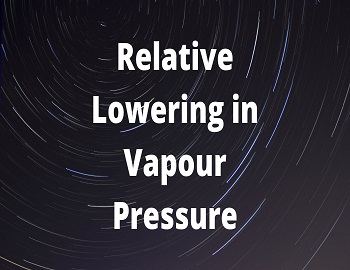Relative Lowering in Vapour Pressure:
When a non-volatile solute is added to a solvent, the vapour pressure of the solution decreases. Let xA be the mole fraction of the solvent, xB be the mole fraction of the solute and p°A be the vapour pressure of the pure solvent and p be the vapour pressure of the solution.
Since solute is non-volatile, there will be no contribution of solute to the vapour pressure and the vapour pressure of the solution will be only due to the solvent. Therefore, the vapour pressure of the solution (p) will be equal to the vapour pressure of the solvent (pA), over the solution, i.e.
| p = pA |
But, according to Raoult’s law, the vapour pressure of the solvent is equal to the product of its vapour pressure in pure state and its mole fraction,
| pA = p°A . xA or P = p°A . xA |
Since xA is always less than one, the vapour pressure of the solution is always less than p°A i.e. vapour pressure of the pure solvent.
| As xA + xB = 1 ⇒ xA = 1- xB ∴ p = p°A . xA ⇒ p= p°A (1- xB) ⇒ p= p°A – p°A xB ⇒ p°A xB = p°A – pA (∵ p = pA) ⇒ xB = (p°A – pA)/p°A ……….(i) |
Where p°A – pA (difference in vapour pressure of pure solvent and solution) represents the lowering in vapour pressure on the formation of solution and (p°A – pA)/p°A gives the relative lowering in vapour pressure. Thus, the relative lowering in vapour pressure of an ideal solution containing the non-volatile solute is equal to the mole fraction of the solute at a given temperature.
Relative lowering of vapour pressure- a colligative property: According to equation (i) the relative lowering in vapour pressure depends only on the molar concentration of the solute (mole fraction) and is independent of its nature. Therefore, relative lowering in vapour pressure is a colligative property.
Determination of Molar Mass of a Solute from Relative Lowering in Vapour Pressure:
The molar mass of non-volatile solute can be calculated from a relative lowering in vapour pressure. A known mass of the solute is dissolved in a known quantity of solution and relative lowering in vapour pressure is measured experimentally. According to Raoult’s law, the relative lowering in vapour pressure on the addition of a non-volatile solute to the solvent is-
| (p°A – pA)/p°A = xB |
Suppose wA and wB are the weights of the solvent and solute respectively and MA and MB are their corresponding molar masses. Then,
| Moles fraction of solute, xB = nB/(nA + nB) |
Where nA and nB are the moles of the solvent and the solute and
| nA = wA/MA , nB = wB/MB ∴ xB = (wB/MB) / [(wA/MA) + (wB/MB)] ……….(ii) |
Since the law is applicable only to dilute solutions, the molar concentration of the solute being very small [wB/MB << wA/MA] and can be neglected as compared to that of the solvent. Thus,
| wA/MA + wB/MB = wA/MA Equation (ii) becomes- xB = (wB/MB) / (wA/MA) ⇒ xB = (wB . MA) / (wA . MB) Substituting the value of xB in equation (i), we get- (p°A – pA)/p°A = wB MA/wA MB or MB = wB MA / wA[(p°A – pA)/p°A] |
Thus, the molar mass of the solute can be determined if the other quantities wA, wB, MA and relative lowering in vapour pressure (p°A – pA)/p°A are known.









Comments (No)